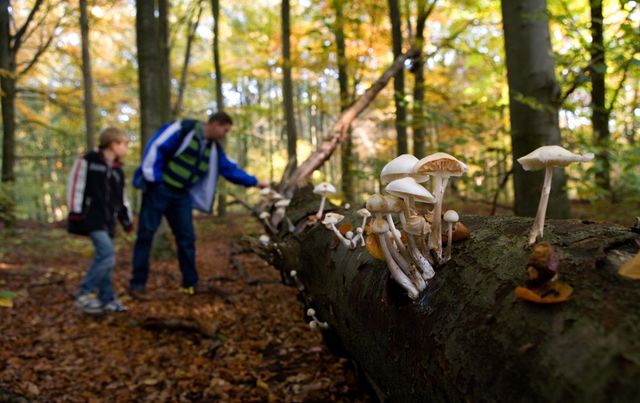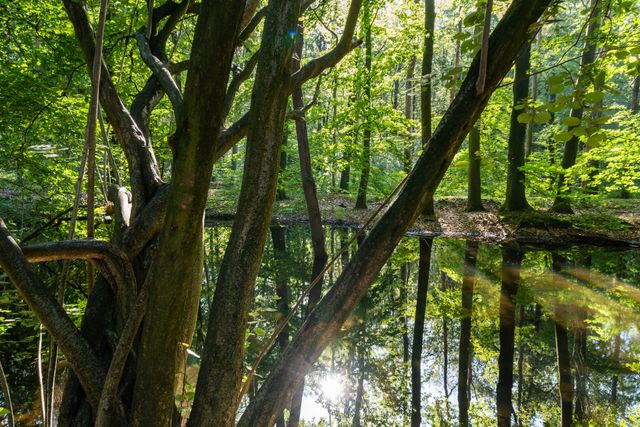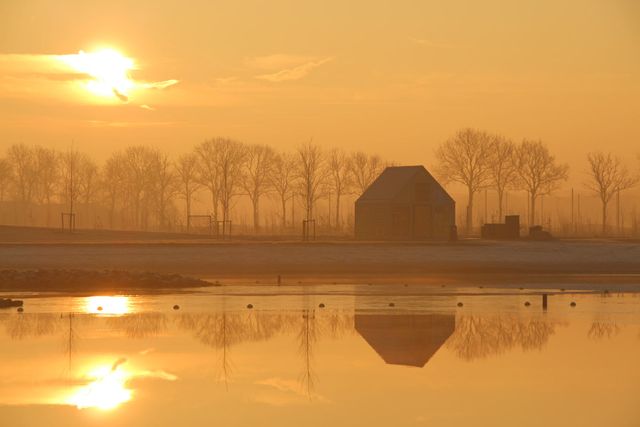Each of our woods has its own charm. And even though they are young, you can still enjoy getting lost wandering in them. The Voorsterbos and the nearby Waterloopbos together encompass 1,000 hectares of nature to explore. Between the thick trees in the Voorsterbos, you can imagine being in an ancient wood. The Kuinderbos is the oldest and largest wood in the Noordoostpolder. It is full of different varieties of plants, butterflies, birds of prey and fungi. If you’re lucky, you may even catch a glimpse of the rare pine marten.
The Voorsterbos was planted between 1944 and 1961, but you wouldn’t think that when wandering through it. The enormous trees and the huge diversity of plants and animals that live there bring incredible variety to the woods. Did you know that this wood is a true fungal paradise? Of the 3500 species found in the Netherlands, 800 are at home here. This is partly due to the chalk in the ground from the seashells that are still present in the former seafloor.
More about the Voorsterbos
Because boulder clay from the last Ice Age is found in the soil, the foresters planted a wide range of trees. They were not sure which ones would do well on that kind of soil, which does not allow much water to percolate through. This resulted in a very varied wood that is never boring.
More about the Voorsterbos
The Waterloopbos forms part of the Voorsterbos. The Waterloopbos National monument is not only a lovely wood to explore, it also has a special history. The Hydraulic Laboratory conducted research there over many years into the action of water. In the wood there are ruins of scale models of about 30 large waterworks from around the world. For example, the Deltawerken were designed there, as were the ports of Rotterdam, Lagos, IJmuiden, Istanbul and Bangkok. With water, dams, weirs and wave machines, reality could be imitated in the wood. Since the departure of the laboratory, nature has slowly reasserted control over the hydraulic models. This has led to a unique interaction between technology and vegetation.
More about the Waterloopbos
In the Kuinderbos in the northeast section of the Noordoostpolder, there is a wealth of unusual plants, fungi, butterflies, birds of prey and predators like the pine marten. Around the Kuinderplas lake, Welsh and Icelandic ponies keep the open places in the woods open. There are walking routes, nature and cycle paths, nature and day camping, playing fields, picnic spots, campfire sites and historical ruins. If you are looking for a great walk with your dog, there is also a "wet nose path" where your faithful friend can run about to their heart’s content.
More about the Kuinderbos
The Wellerwaard is the youngest nature reserve in the Noordoostpolder. It is large, spacious in design, and highly recommended for anyone who wishes to enjoy nature, swimming, beach or the wind in your hair while walking the dog. Along the way you come across robust picnic tables, sturdy bridges and decks, fun playgrounds for the children and fire pits for a cosy barbecue. Relax after a walk or swimming in the restaurant Bij Ons in the Wellerwaard with a delicious cup of coffee, lunch or dinner.
More about the Wellerwaard
The Schokkerbos covers 85 hectares and is growing in soil consisting of peat, boulder clay and clay. It is situated along the western edge of the World Heritage Site of Schokland. The wood is 50 years old and consists primarily of ash, oak and coniferous trees. Boulder clay and peat are responsible for an uneven and slow growth of the forest. This provides more opportunities for ferns, fungi and mosses: experts have found 75 varieties of moss along with over 350 varieties of fungi, 30 of which are rare. The wood is also home to typical forest plants, like the wild honeysuckle. Birds of prey like hawks, buzzards, sparrowhawks and long-eared owls like living there, as do many songbirds and deer. Special den boxes have been hung near the Gesteentetuin for the pine marten.
More about the Schokkerbos